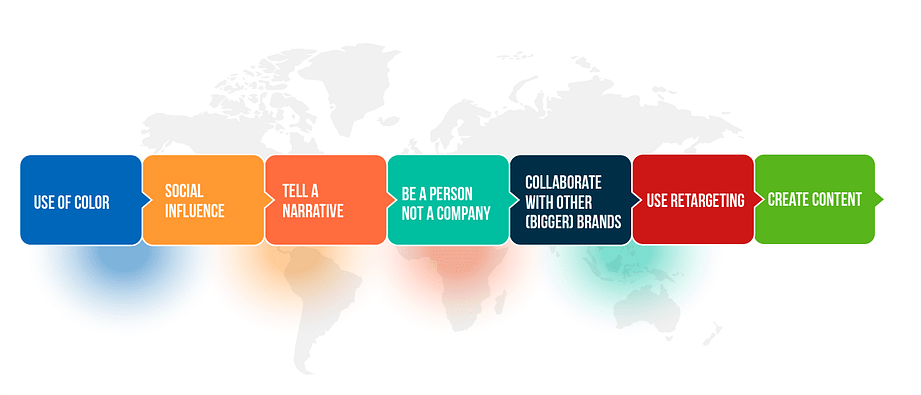Does it feel like you have stunning services or products, but still many potential clients don’t know about your business or what you offer? However, it doesn’t matter how long you spend on marketing and advertising. people are still not aware of your product and company. Brand awareness populates your products and company among people.
Beyond marketing and advertising, brand awareness must be the priority. Even, 90% of marketers have set brand awareness on their top goals. If you want to increase brand awareness for your business, then you need to focus on your logo, colors, and font marketing to create a visual identity among potential customers again and again until they recognize your brand.
Let’s discuss Brand Awareness.
What is Brand Awareness?
“Brand” can be your logo, color, or anything which will help customers to recognize you easily. Brand awareness establishes loyalty, trust, positive association among your potential customers, and builds invaluable brand equity. But it is not as simple as writing things or it doesn’t happen from normal marketing and promotion.
If you expect to increase brand awareness by running simple Facebook and Instagram campaigns, then you are wrong, you won’t go very far. Brand awareness needs efforts to grab the customer’s attention and to create an unforgettable identity among potential customers. Boosting brand awareness is not an overnight task.
It’s not only for big businesses or companies. Although you might not achieve this with your small business, that doesn’t mean you can’t do a lot more to boost the awareness of your brand.
.
Are you searching for ways to boost the brand awareness of your business? Want more potential customers or increase your small business?
.
Here are the ways you can put it into today’s list to increase brand awareness.
Ways to Increase Brand Awareness

Use of Color
The use of colors can help you to build trust, loyalty, and also make your business’s visual identity among peoples. The colors of your brand can tell more than you imagine about your business. Even big companies or most popular brands have a strong bond with their logos. Companies of the food industry, clothes industry, IT Company like McDonald’s, Nike, Infosys, Raymond, and many more, their colors tend to reflect their branding.
This is because of the intensity of colors and their ability to expand brand awareness. According to the survey, we have found that brand colors and logos influence 70 to 80% of people to buy their products. Like words, Colour can make us feel emotions. This describes that the correct choice of colors doesn’t only strengthen the brand association, but it also affects your total sales.
The right use of colors increases branding and gives a strong impact on your business. Further examination shows that brand acknowledgment can be expanded by up to 80% by using the right colors throughout marketing, advertising, logo designing, and packaging. Similarly, if the color of an item doesn’t suitably speak to its purpose, this can confound and even harm a brand’s sense of identity.
Let’s take a quick review of color psychology and some examples that show you how color influences a customer’s impression of a brand or its items.
Red- This color stands for anger, excitement, love, strength, and passion. This color is very popular in the food industry, the apparel industry as well as health, entertainment, and so on. Examples – Mcdonalds, KFC, Pizza Hut, Coca-cola, Ambulance (the color of + is red), Raymond, YouTube, and many more.
Green- This color belongs to nature and widely stands for calmness, safety, growth, prosperity, wealth, and freshness. Green will in general be related to well-being alongside the feeling of peace and serenity. This color is mostly used by banks for money-making, grocery stores to promote natural, fresh, and organic products, electronics, and hospitality. It creates a unique brand identity for the company. Examples – Jaguar, Tropicana, Tic-tac, whole foods market, Sobeys, TD Bank, etc.
Blue- Blue is the color of nature. The color of the water and sky is blue. Blue is mostly preferred by males and 30% by females. Light and Dark are the two variations of blue color.
- Light Blue- This light tone blue color emphasizing trust, safety, openness, cleanliness, and innocence. This color is commonly used by the beauty, medical, and healthcare industries. Examples – Oral B, Domestos, messy, Unilever, etc
- Dark Blue- Dark Blue color stands for security, technology, professionalism, confidence, intelligence, and reliability. This color is mostly used by technology, social networks, and financial institution brands. Examples – Ford, Samsung, Facebook, HP, PayPal, etc.
Purple- Purple indicates royalty, faith, courage, honor, creativity, and luxury. Big brands have different reasons to choose this color. Some are using this color for their sensuality, power, luxury, boldness, and mystery. Examples – Benq, Cadbury, Asprey London, Liberty London, etc
Black- Black is another famous color option for brands. Black is the most classy color and it is perfectly fit for luxury products, powerful elements, and blending the classic. Black summons an incredible, sophisticated, luxurious, and modern feeling. Examples – Disney, Adidas, Nike, Mercedes-Benz, Nestle, Calvin Klein, Chanel, etc
Many more colors are available and have their own story. It is on you to choose the right color for your business. Do not choose the color which you like, choose the one that can tell your business motive.
Collaborate with other (Bigger) Brands
This is mainly for small businesses. If you are a small brand and ready to boost brand awareness, then it’s time to collaborate with other big brands. Open your Social Media and start searching for the brands you would like to work with. Social Media is the best for engaging, once you have done with engaging, ask them to collaborate. Giveaways on social media are the best and simple way to boost brand awareness.
Collaborating with other brands not only allows you to bring a new brand voice and perspectives but also encourages you to build credibility and legitimacy within your community. It allows both brands to take advantage of each other’s audience and sets up your brand image as a decent corporate resident that cultivates transparency and collaborations for the benefit of your potential clients.
Tell a narrative
Do you want everyone to remember your brand? Start with storytelling. The story builds emotional connections with people and connects deeply inside so that they won’t forget your name soon.
The most powerful marketing tactic is Storytelling, whether you are promoting your brand or marketing your products. Creating a story around your image adapts it and gives it profundity.
What should your account be about? Anything, as long as it’s actual. Stories can be about your founder, about your first product idea, and about how you grew your small business.
People like hearing tales about one another. Authenticity is significant, and it can prompt a major lift in brand awareness.
Social Media Presence
In today’s era, people are mostly busy on social media, talking to each other. Young ones or oldies both have a presence on social media. If you want to reach your potential customers, you need a social media presence.
If you are only trying to sell your products on social media, you won’t be known. To increase your brand awareness, you should post regularly on social media. Remember that consistent posts help people to remember your brand, which strengthens the bond between you and your audience and increases trust and loyalty. Post on Social Media about your products, business, services, and share all the latest information about your business or newly launched product, so that people can become aware of your business, products, and so on.
Do you want to be a trusted and popular brand then you must make efforts to interact with your audience. Reply to comments, answer your audience’s question and be active on social media. Use your social media like you are trying to make friends, not trying to make money.
Be a Person, not a Company
Reach your potential like a person not like a company. When you make new friends, you like to discover their passion, interests, hobbies, likes, dislikes, and more. You also pay attention to how they are talking and what they like to talk about, and more which helps you to know about them. Do the same with your branding, promote your business yourself. To leave an impact on your audience, choose the right words, the right way to introduce your brand to a new friend.
Use Retargeting
Retargeting is the best way to win back those clients who may have visited your site or even placed something in their cart but didn’t purchase. Retarget your clients any place you can! You will in all likelihood have the option to pinpoint where in the buying journey your clients fall off the map. This is the place where you need to execute a retargeting system that permits you to build brand awareness and reel those clients back in.
You can collect data from your customers who visit your sites and use it to retarget them with Google ads, email marketing, and social media. Retargeting advertisements are put across all the websites your client’s visit. Soon they’ll be seeing your business all over the place – on their #1 websites while shopping on the web, and so forth. This gives the feeling that your brand is a lot bigger than it truly is.
Create Content
Nowadays, content is the best way to reach your potential customers by sharing opinions, issues, and solutions with them because today’s customers use the internet for all questions, information, and concern. It is the simplest way to motivate someone to make a purchase. If people don’t buy products from your business but they will definitely start recognizing your brand after reading your blog, watching videos, and other creative content that you create.
Rather than telling how your business can help, show your potential customers that you understand their pain points and can solve problems by creating content like video content, blog posts, and e-books. Keep creating and sharing useful blogs, videos with your target audience.



